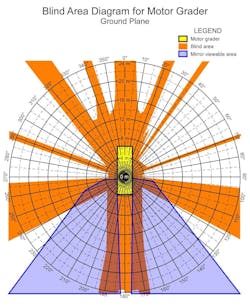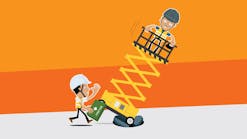The June 2014 edition of Workplace Solutions, a publication of the National Institute for Occupational Safety and Health (NIOSH), includes an article entitled “Preventing Worker Injuries and Deaths from Backing Construction Vehicles and Equipment at Roadway Construction Worksites.”
The article cites a Bureau of Labor Statistics report stating “of the 962 fatal workplace injuries at road construction sites from 2003 to 2010, 443 were due to workers being struck by vehicles or mobile equipment. Workers were fatally struck 143 times by vehicles or mobile equipment that was backing up.”
Designing for Visibility
According to Doug Morris, Komatsu’s director of product marketing, designing machines to provide good visibility for the operator is a constant concern. He cites several examples of the company’s efforts in this regard, including the steeply sloped hood on its small dozers—achieved by positioning the cooling system at the rear of the machine, thus providing “unrivaled visibility to the blade,” says Morris—and the integration of the ROPS posts into the cab structure of these machines to make the posts less obtrusive.
For its articulated trucks, Komatsu has changed the contour of the hood and designed a center-of-cab seat position, “simple changes that yield significant improvements in visibility,” says Morris. The company also added a standard rearview camera with an optional right-side camera to its Tier 3 excavator models in order to increase job-site awareness for the operator, he says, and continues to incorporate standard rearview systems into new product lines as they are released.
Visibility enhancements for Volvo Construction Equipment’s new G Series articulated trucks, says product manager Henrik Larsson, include a standard rearview camera, new sloped hood, and wide-angle mirrors, designed to help reduce blind spots and provide clear views to the wheels when backing and to the payload when dumping. An all-glass entry door provides excellent sight lines to the hitch area, says Larsson, and the cab’s large windows and thin corner posts further contribute to reduced blind spots.
Caterpillar’s new D Series skid steer and compact track loaders have a wide, frame-less front door “that delivers an exceptional view of the work tool and job site,” says Kevin Colemen, senior marketing engineer, and a standard convex rearview mirror provides a panoramic view to the sides of the machine, which is further enhanced by a new narrow-profile lift-arm design. An optional rearview camera, which Coleman says is an industry exclusive, provides a comfortable view to the work area behind D Series models.
Although visibility around an asphalt-paving machine is reasonably good, says Bill Rieken, road-building specialist for Bomag, the company’s Tier 4-Final models have enhanced forward sight lines resulting from a redesigned hood.
“All work situations are potentially dangerous,” says Rieken, “and you have to continually think about what you’re doing. On asphalt-paving projects, the danger is not so much from the paver, but more from trucks backing to the paver and vehicles moving around the site in close proximity.
The danger of workers being struck by construction machines and heavy trucks is an ever-present threat on busy job sites. The problem, in part, results from workers becoming less attentive as they grow accustomed to being in proximity to these vehicles, sometimes even ignoring backup alarms that seem always to be sounding.
And, too, workers often assume that since they have a vehicle in full view, the vehicle operator can see them just as well. That’s a dangerous assumption, because all construction machines and trucks have “blind spots”—areas around the vehicle not visible to the operator—rsulting simply from the vehicle’s inherent design. Equipment manufacturers strive for optimum visibility, of course, but perfection in this area is virtually unattainable, and the resulting blind spots contribute significantly to incidents of worker/vehicle collision.
According to David Fosbroke, statistician with NIOSH’s Division of Safety Research, NIOSH considered vehicle blind spots to be of sufficient concern that the organization commissioned development of blind-area diagrams for 38 construction vehicles and five mining machines. The intent, says Fosbroke, was to raise awareness about the hazards of working around construction vehicles by analyzing what operators can’t see.
Fosbroke suggests that equipment-owning companies might use the blind-area diagrams when laying out job sites (to minimize placing workers in areas where vehicle operators have limited visibility) and as training aids to illustrate typical blind spots around various equipment types. As an awareness exercise, says Fosbroke, have workers sit in the cab and take note of limitations in the operator’s field of view while fellow workers walk around the vehicle.
Fosbroke cautions, however, that blind-area diagrams might not reveal the entire visibility story: “With a compactor, for instance, the blind areas are small, but since the operator’s focus is often on the edge being rolled—looking at the ground on one side of the machine—then virtually the entire opposite side of the machine becomes a blind area. Ground workers must be reminded that the way a machine is used can result in unexpected blind areas.”
Further, NIOSH is analyzing “internal traffic control plans” as a possible means for mitigating worker/vehicle collisions. Just as road-construction sites have a plan to control traffic through work zones, says Fosbroke, an internal plan establishes on-site vehicle travel patterns, sets boundaries and travel paths for ground workers, delineates worker-free zones in areas of concentrated vehicle traffic (such as around storage areas), limits access to the site, and eliminates vehicle-backing maneuvers whenever possible.
NIOSH Resources
Blind-area diagrams:
www.cdc.gov/niosh/topics/highwayworkzones/BAD/imagelookup.html
Internal Traffic Control:
www.workzonesafety.org/runover_backover/itcp
Preventing worker/vehicle collisions:
www.cdc.gov/niosh/docs/2001-128/
www.cdc.gov/niosh/docs/wp-solutions/2005-101/
www.cdc.gov/niosh/docs/wp-solutions/2014-125/
Site-specific rules in the plan, says Fosbroke, might include establishing speed zones, prohibiting workers from approaching a truck until it stops, and prohibiting pickup-truck parking along vehicle travel paths, a situation that could force heavy vehicles to swing around pickups and crowd work crews.
Fosbroke admits that formulating and implementing internal traffic control plans can be difficult, considering the large number of on-site entities—subcontractors, trucking companies, material suppliers, and the like—that must understand and comply with the plan. Based on NIOSH’s preliminary data analyses, however, Fosbroke says that such plans did reduce worker exposure to on-site vehicular traffic in some cases—though not in all. This suggests, he says, that internal traffic control plans offer potential for making working around mobile equipment safer.
Proximity-warning systems
Of course, all of this begs the question: If vehicle operators could be warned that ground workers are in dangerous proximity, or if vehicle operators could be warned that another vehicle is dangerously close, wouldn’t job sites be much safer?
Suppliers of proximity-warning and collision-avoidance systems answer that question in the affirmative and continue to develop and refine such systems, which employ a varied range of technology, including video, GPS, radar, radio-frequency identification (RFID), and magnetic fields.
Balfour Beatty Construction, headquartered in Dallas, and among the nation’s largest commercial construction firms, sees value in such systems and requires a radar-based proximity-warning system on all telehanders used on its job sites.
“Telehandler use on our projects is increasing exponentially,” says Steve Smithgall, senior vice president of safety and health management for the firm. “They’re useful, versatile machines, but they create hazards resulting from blind spots and their unique steering capability. We have an agreement with a national equipment-rental firm to provide proximity sensors on any telehandler rented by a subcontractor for a Balfour Beatty project, because we believe these systems contribute to a safer working environment. We’d like to see them as standard equipment on telehandlers—it’s an effective way to reduce risk.”
Vision enhancement
You’ve probably noticed that more machines today are available with video cameras that display images on an in-cab monitor to increase operator awareness of the machine’s surroundings. Most are rearview systems, but cameras can be positioned anywhere on the vehicle, allowing operators to toggle among images or to view multiple images on a divided screen.
According to Eric Herron, technology marketing consultant for Caterpillar, work also is being done on displays that integrate multiple camera views to provide a “bird’s-eye-view” of the machine’s perimeter. On larger Caterpillar machines, says Herron, the company’s DETECT system can combine multiple video cameras with multiple radar sensors to detect objects within critical zones around the machine, providing both an audible warning and visual indicators that detail distance and location of detected objects.
Radar
According to Teresa Prisbrey, director of marketing for Preco Electronics, the company frequently consults NIOSH blind-area diagrams when developing its radar-based proximity-warning systems for various types of construction vehicles. In business since 1947, Preco supplies its radar-based systems both for factory installation by equipment manufacturers and for in-field retrofits by its own technicians. (The PreView Radar system is that used for Balfour Beatty telehandlers.)
According to Preco Electronics’ Peter Evans, vice president of sales and marketing, the PreView system uses a patented pulsed radar signal of the company’s own design. The signal, which can range in coverage from 10 to 32 feet, allows detection of both stationary and moving objects—a capability that not all radar systems can provide, he says. In addition, says Evans, the pulsed signal provides consistent-pattern detection, can handle any environment and inclement weather, and allows shaping the signal to a vehicle’s design and application.
Sensors emit a fan-shaped energy pulse, and when the signal detects an object, an in-cab display provides an audio/visual warning, which increases in intensity as the distance between machine and object diminishes. The company also provides an integrated system that combines radar sensors with cameras, providing an audio warning and a full-screen image of the detected area, which also indicates distance to the object and camera location.
“Radar gives a gentle tap on the shoulder that reminds the operator ‘there’s something back there,’” says Prisbrey, “and operators learn to use the system as a tool to judge how far away a detected object might be. As a company, we believe that training is an integral aspect of every installation, because operators have to buy into the system and believe that it will help them avoid damaging equipment or causing injury.”
RFID
Radio frequency identification (RFID) serves as a proximity-warning system by sending out a radio wave from an antenna on the machine, and when the signal is reflected by a “passive tag” worn by a ground worker, the machine operator receives an audio/visual alert that a worker is in the machine’s path. An “active tag,” which has its own battery and electronics, can provide a warning for the ground worker as well.
Jonathan Fava, president of Scan-Link Technologies, says that the company’s passive RFID Armour system has an optional external alarm and flashing light at the rear of the machine to alert ground workers that they’ve been detected. Most of Scan-Link’s systems are sold for rear-of-machine detection, says Fava, but installing multiple antennas (the signal is directional) can increase coverage around the vehicle. The antenna creates a balloon-shaped signal as large as 20x13 feet, says Fava, but signal size can be limited if the machine is working in confined areas, such as on sewer and water projects.
RFID is line-of-sight technology, says Fava, which means that the antenna and tag must “see” each other and that signals can be blocked by large metal objects and human bodies. To ensure that workers are continually protected, no matter their position, says Fava, the Armour system includes hardhats and vests with multiple tags—10 around the hat and 14 concealed around the vest.
The system can also function as a vehicle/vehicle collision-avoidance device, says Fava, when each machine on site is equipped with an antenna and a custom tag, which does not recognize the signal from its own machine’s antenna, but is sensitive to those of other machines. In addition, he says, tags can be affixed as “markers” to stationary objects, warning machine operators that an obstruction is present. The system provides a different alert for objects than for workers, and the worker signal takes precedence.
System capabilities also include recording information about detection incidents, which can be wirelessly extracted. Under development, says Fava, is a method for integrating this data into a machine’s telematics system for sending e-mail or text alerts to safety personnel that detection events have occurred.
Magnetic field
In the late 1990s, the Mining Safety and Health Administration (MSHA) requested NIOSH to investigate proximity-warning systems for alerting underground miners that they were too close to continuous mining machines. As a result, NIOSH developed the Hazardous Area Signaling and Ranging Device (HASARD), which employed magnetic-field technology.
Frederick Energy Products subsequently licensed the technology from NIOSH, says Jimmy Helms, Frederick’s sales and marketing director, and has developed patented refinements that are now incorporated into the company’s Hit-Not proximity-detection/collision-avoidance system.
According to Helms, the Hit-Not system uses a small magnetic-field generator (about 6 inches long, 3 inches square, and attached near the top of the cab) to envelope the machine in an oval-shaped magnetic field, similar to a watermelon shape, says Helms. A standard generator produces an adjustable field that can extend to 49 feet both forward and behind the machine, and an XL generator pushes the field out to 80 feet in both directions. The field extends proportionally to the sides of the machine at 80 percent of its longitudinal dimension.
The magnetic field communicates with personal alarm devices (PADs) worn by ground workers, who, along with the machine operator, receive a two-stage audio/visual alert (“warning,” then “danger”) as the threat of collision escalates. (The two-stage warning results from the generator’s ability to actually produce two fields, one within the other.) Because the magnetic field passes through virtually any obstruction, says Helms, the system does not depend on line-of-sight communication.
The Hit-Not system, says Helms, also can be configured to set boundaries around restricted areas and also to function as a vehicle/vehicle or vehicle/stationary-object collision-avoidance device, the latter involving mounting a magnetic-field generator vertically on an object to create a circular protective field.
Estimated costs for the Hit-Not system’s components are $900 or $1,300 for a generator (standard/XL) and $500 for the standard PAD.
GPS-based collision avoidance
According to Todd Ruff, business development manager, North America, SAFEmine Technology (USA), the company’s traffic-awareness/collision-avoidance system combines GPS (which determines vehicle location, speed, and heading) with a vehicle-to-vehicle radio network “so that vehicles are continually talking to each other,” says Ruff, “letting each other know where they’re located.”
The system has two functions, says Ruff. The traffic-awareness function provides vehicle operators a visual representation of nearby traffic via an onboard display with a circular arrangement of LEDs that indicates the relative positions of other vehicles, for example, the 12-o’clock LED indicates traffic straight ahead. The color of the LED indicates distance to other vehicles, with green indicating safe distances.
The second function, collision avoidance, takes into account vehicle type, speed, and direction of travel. If the system determines that two vehicles are on a collision course and that the safe-distance threshold has been breached, then the corresponding LED flashes red and the operator receives an audible warning.
“There’s intelligence involved in the system,” says Ruff. “It isn’t beeping at you simply because another vehicle is nearby, it’s beeping because there’s risk of collision.”
Until now, the system has been used only for mining applications and for construction projects within mines, primarily because vehicle access to mine sites is tightly controlled. If a temporary system is needed for a visiting vehicle, the vehicle can be quickly equipped by placing a portable collision-avoidance unit on the roof and a display module on the dash.
But the technology is transferable to a wide range of construction applications, says Ruff, perhaps with a bit of added sensing capability:
“The challenge on construction sites is that you might have multiple contractors at work, and if there isn’t restricted access to ensure that all vehicles entering the site have a traffic-safety system, then some vehicles won’t be protected. A possible solution in this situation might be to augment the collision-avoidance system with radar.” (SAFEmine’s TrackingRadar integrates with the GPS system and uses sensors that can detect and track the path of vehicles and ground personnel, as well as identify stationary objects.)
The company’s SafetyCenter and ShovelAssist systems, in fact, integrate the GPS-based collision-avoidance system with TrackingRadar and up to six video cameras. Data from these various sensors are integrated into a single interactive visual display that provides operators an awareness of objects surrounding their machines, along with alarms prioritized according to the danger level.





